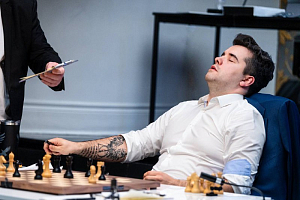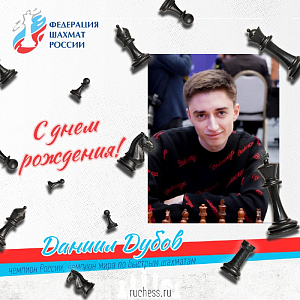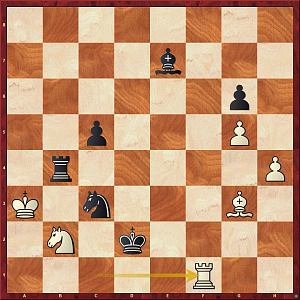12 July 2015
Nothing Else but Nice Games
The mid-distance rounds of the Russian Higher League under review by Dmitry Kryakvin.
There have passed six rounds of the Kaliningrad tournament, and an incredible intensity of the struggle makes itself felt more and more. Several games, which directly affected the breakdown of places in the leading group, were sealed by severe blunders. What is to be done? Anything can happen in chess! Maybe it is due to the summer heat or the time zone change, anyway it is worth remembering the huge blunder committed by Hammer from the recent Stavanger tournament, which determined the final tournament victory by Veselin Topalov!
Zvjaginsev – Shariyazdanov

The encounter between the Elista-1998 Olympiad heroes from the first and second Russian teams saw the recently returned to chess Andrey Shariyazdanov confidently solving his opening problems only to put himself suddenly in the line of direct fire of Vadim Viktorovich:
28... Kf7?? 29.Nde5+! Black resigns.
Frolyanov – Alekseev
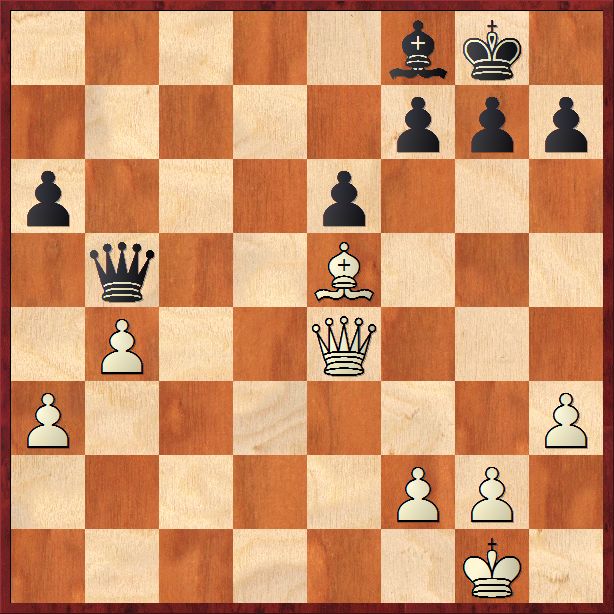
A tactical punch from the game between the nemesis of favorites Dima Frolyanov and the former national champion Evgeny Alekseev was a lot more elegant.
Black needs to demonstrate a certain amount of accuracy as 32...Qa4 can be met with 33.Qa8. However, at his disposal is the choice between the principled continuation 32...a5 or the careful one 32...h6. Evgeny voted in favor of pressing ahead with the activation of his kingside pawn majority via 32...f6? and I got a very tough 33.Bd6! in response. Believe it or not, but the pawn cannot be salvaged! The smashing plunge of the queen on a8 and the capture on f8 are in the air, whereas 33...Qd5 would have resulted in a lost pawn ending. The technical phase saw the flawless performance by Frolyanov, who reached "+2", just as did Zvjaginsev, which allows both grandmasters sharing the second place.
The spectacular achievements of the leader of the women’s section of the competition Alina Kashlinskaya was elaborated in great detail by the RCF expert Sergey Shipov in his substantial video reviews in Russian, so let me tell you about the battles conducted by the pursuers of the Moscow grandmaster.
Ovod – Bodnaruk
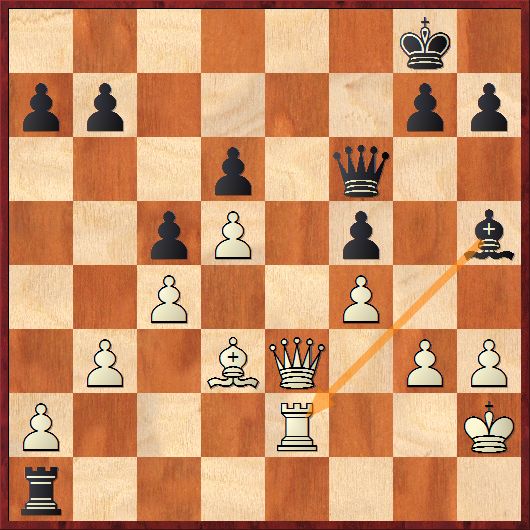
Of course, the current rating does not reflect Evgenija Ovod’s powerful chess might as a many-times national superfinalist, and in a face-to-face duel of Petersburg stars the younger chess player could have had a very hard time.
White’s rook is under attack, and after the careful 29.Rc2 the game soon ended in a draw. Meanwhile, Ovod could have carried out a very beautiful combination: 29.Bxf5! Qxf5
It is obvious that 29...Bxe2? is no good in view of 30.Qe8+ Qf8 31.Be6+.
30.g4 Bxg4 31.hxg4 Qf7 32.f5
The queen lunge on e6 is threatened with a winning rook ending, but it appears that Evgenija was not sure about 33...h5. How to go about protecting the g4-pawn, should the king be dispatched for this assignment? It is at this moment that a puzzle-like 33.g5!! Qxf5 34.Qe8+ Qf8 35.g6! comes into play.
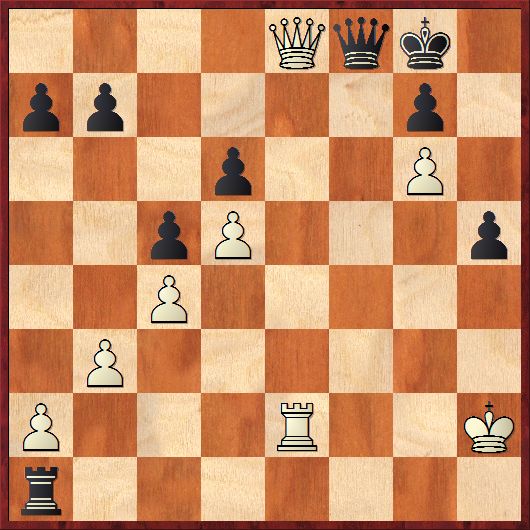
It is necessary to play 35...Rf1, and then the outcome of the game is sealed with the help of an elegant geometrical motif: 36.Qe6+ Kh8 37.Qh3 Qf4+ 38.Kg2 winning. However, anyone could miss such an effective opportunity.
Even more counterintuitive position arose in the encounter between the direct pursuers of Alina Kashlinskaya, Anastasia Savina and Marina Guseva. Nastya is in a rush to her first Superfinal, and Marina is breathed in with new forces from having moved into the chess region of Stavropol. The Muscovite was close to winning, but Guseva fought to the last bullet, when the remainder of the pawns on the board (and White was up one of them) was becoming reduced more and more.
Savina – Guseva
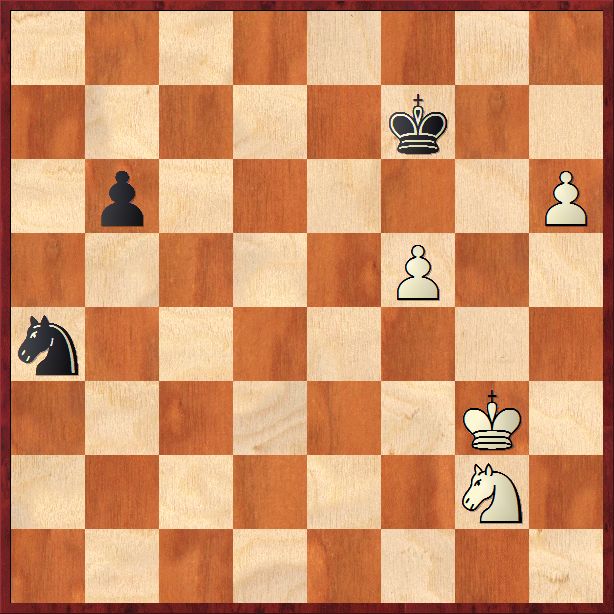
Savina opted for a logical continuation 77.Kg4, but Marina was on the alert: 77...Nc5! 78.Kf4 Nd7 79.Ne3 b5 80.Nd5 Kg8 81.Kg5 Kh7 82.Kh5 b4!
Having timely parted ways with his pawn, Black succeeded in eliminating the rest of the rival’s infantry.
83.Nxb4 Nf6+ 84.Kg5 Ne4+ 85.Kf4 Nd6 86.f6 Kxh6 87.Ke5 Kg6 88.Nc6 Ne8 89.Ne7+ Kf7 90.Nd5 Nxf6 and the game ended in a draw.
However, the position on the diagram has a true study hidden in itself! It turns out that White could have forced the transfer of his knight to d6, where it would interfere with the advance of the enemy’s remote passed pawn while helping to pave the way for his own ones to become queens!
77.Nf4 Nc5 78.Ne6! Ne4+
After 78...Nxe6? 79.fxe6+ there appears a typical case of double outside passed pawns.
79.Kf4 Nf6 80.Ng5+ Kg8 81.Ne4 Nd7
In the case of 81...Nh7 82.Ke5 Kf7 83.Nd6+ Kf8 84.Ke6 Kg8 the black knight is not so well-positioned, and White only needs to calculate the consequences of transiting into a pawn ending: 85.Ne4! b5 86.Nf6+ Nxf6 87.Kxf6 b4 88.Ke7 winning.
82.Nd6!

Is it possible to win this position? It is simply nothing short of being fantastic! Four attackers outmaneuver two defenders within the confined space of the chessboard.
82...Kh7 83.Kg5 Nf8 84.f6, and Black is up against a rather regrettable choice of alternative continuations. In the case of 84...Ne6+ 85.Kh5 Nf4+ 86.Kg4 Ne6 87.f7 or 84...b5 85.Nxb5 Ne6+ 86.Kh5 Nf4+ 87.Kg4 Ne6 88.f7 there would have arisen similar positions where White is winning by pressing the opponent’s knight out of his defensive fortifications:
88...Kxh6 89.Kf5 Nf8 90.Kf6 Nh7+ 91.Ke7 Kg7 92.Nc7 Kh6 93.Ne6 Kh5 94.Nc5! Kh6 95.Nd7, when Black cannot place his king on g6, whereas 95...Kg5 96.Nf8 or 95...Kg7 96.Nf6 are not at all difficult to detect.
It is an instructive, but rather storybook-like ending, which would have been won only by Carlsen when in good shape, or by a team of Soviet grandmasters at adjournment.
After completion of six rounds the situation in the women's section of the tournament is as follows: 1st place - Kashlinskaya with 5 points, 2nd-4th places - Savina, Pustovoitova, and Guseva with 4.5 points, and as many as 7 players having 4 points each. The fight has just begun!
* * *
It is high time we moved from the omissions committed by the participants of the Higher League to their creative rises and masterpieces. The primacy in this field belongs, no doubt, to Alexander Motylev, who has won three games in a row in a brilliant style! The national men's team coach is on the outright rampage, rushing into Chita together with his trainees.
Motylev – Pridorozhni
Sicilian Defence
1.e4 c5 2.Nf3 a6
The O'Kelly line, discarded previously by the old opening theory, has recently started gaining popularity as a means of combating the Rossolimo’s lunge of the bishop to b5. It was once believed that White could play almost anything to his liking on move three other than 3.d4?! схd4 4.Nхd4 Nf6 5.Nc3 e5. The era of Stockfish, however, has breathed new life into this direction.
3.c4
The setup with an isolated pawn that could have appeared after 3.c3 d5 4.exd5 Qxd5 5.d4 Nf6 6.Be2 e6 7.0-0 cxd4 8.cxd4 Nc6 9.Nc3 Qd6 10.Bg5 Be7 is not everybody's cup of tea, and although Alexander has recently defeated a player rated over 2300 in this position, he makes up his mind to go for something more solid against such a consistent chess player as Aleksei Pridorozhni.
3...Nc6 4.d4 cxd4 5.Nxd4 e5 6.Nc2 Bc5!
It is this bishop maneuver that Black pins his hopes on. His ideas are well illustrated by the opening outcome of the game Reinhart - Rapport (2015): 7.Bd3 d6 8.0-0 Nge7 9.Nc3 0-0 10.Be3 Be6 11.Nd5 Bxe3 12.Ncxe3 Nd4 with a reasonable position, inherent to the early Chelyabinsk line.
7.Nc3 d6 8.Be2 Nf6 9.0–0 Be6 10.Kh1
The straightforward 10.Be3 Bxe3 11.Nxe3 Rc8 12.b3 0–0 13.Qd2 Nd4 yields nothing, therefore Motylev puts his stakes on the f2-f4 advance.
10...Rc8
It would have been no less interesting to test 10...Nd4, in order to meet 11.f4 with 11...Nxe2 12.Qxe2 Ng4!, and you cannot play 13.f5? (13.g3 h5!) in view of 13...Nxh2! However, Aleksei’s choice was equally powerful.
11.f4 h6
11...exf4 12.Bxf4 is obviously an inferior option in a position where the Black’s dark-squared bishop is on с5, rather than on е7.
12.b3 Nd4 13.Bb2 0–0 14.Na4!

The smart lunge of Motylev’s knight to the rim of the board threw Black into a dilemma and it appears that Pridorozhni failed to get it right.
14...Nxe2?!
Although interesting is 14...Nxe4!? 15.Bd3 f5 16.Nxc5 dxc5 17.fxe5, it looks like the strongest continuation is 14...Nxc2 15.Qxc2 Bd4 with the idea of 16.Bxd4 exd4 17.Rad1 b5! 18.Nb2 Qb6.
15.Qxe2 Ba7 16.fxe5 Ng4 17.Bd4!
Now in the case of 17...Bxd4 18.Nxd4 Nxe5 19.Rac1 Re8 20.Qd2 White’s advantage is stable together with the sustained pressure on the opponent, which was nothing to Alex’s liking. However, the Musketeers attempt to confuse Motylev led Black to a disaster.
17...Bb8? 18.Nb6!
Not falling for 18.exd6 Qxd6 19.g3 Rfe8.
18...Rc6 19.Nd5 dxe5 20.Bg1 Bc8
More stubborn was 20...Rc8. However, the bigger part of the board is controlled by White and his game is rather uncomplicated: 21.Rad1 Qg5 22.Nce3.
21.Rad1 Qh4
Pridorozhni’s rook was not destined to join the haunt on the white king. Motylev has calculated the forced sequence and found out that Black was simply losing a piece.
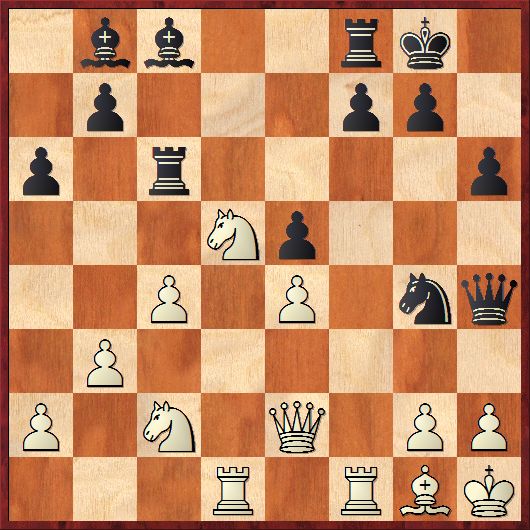
22.g3! Qg5
22...Qh3 23.Ne7+.
23.h4! Qd8 24.Nde3 Qa5 25.Nxg4 Qxa2 26.Nge3 followed by winning shortly.
The next in the way of the Ekaterinburg grandmaster was Vladimir Fedoseev, who is one of the main promises of our younger generation of players along with Artemiev and Dubov. Last year Volodya failed to qualify into the Superfinal only because of his youth maximalism, although he was one of the best in Vladivostok in terms of the quality of the games.
Fedoseev – Motylev
King's Indian Defence
1.Nf3 Nf6 2.g3 d5 3.Bg2 c6 4.0–0 Bg4 5.d4 e6 6.Nbd2 Nbd7 7.Re1 Be7 8.e4 dxe4 9.Nxe4 Nxe4 10.Rxe4 Bh5 11.c3 0–0 12.Qb3 Qb6
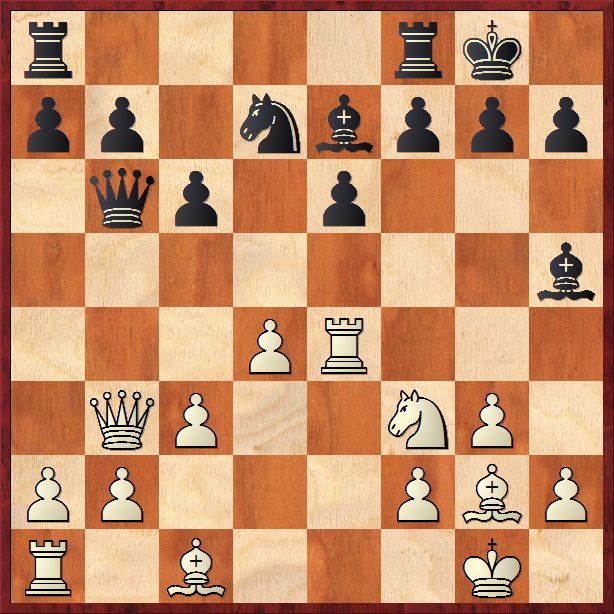
Interestingly, the first to introduce this concept for Black up to the very last move was Sergey Shipov. The follow-up of his game was 13.Re1 Rfd8 14.Bf4 Nf6 15.Ne5 Nd5 16.Bc1 (stronger play was demonstrated by the Chinese player at the last Olympiad: 16.Bd2! Qc7 17.c4 Nf6 18.Bc3 Rab8 19.Qa4, as in Ju Wenjun – Gunina, 2014) 16...Rac8 17.Nc4 Qc7 18.Ne3 Nf6 19.a4 b6 20.Nc4 Nd5 21.Ne5 c5 22.dxc5 Bxc5 23.Nd3 Bd6 24.Bg5 Be7 with a draw, as in Giffard - Thorns, 1999. However, it yet remains to be seen what Motylev had prepared against the Chinese order of moves since Volodya was the first to sidestep.
13.Nd2 Bg6 14.Re1 Bd3?!
More precise is 14...a5! 15.Nc4 Qa6, as in Friedman - Naumann, 2010, when the black queen is given room to retreat to a7 and the black army is about to complete its development. Now Alexander is in for a bad patch.
15.h4!
Fedoseev is not content with the insipid 15.Nc4 Qa6 16.Ne5 Nxe5 17.Rxe5 for quite obvious reasons.
15...h6 16.Re3 Bh7 17.Nc4 Qc7
This time around 17...Qa6 18.a4 results in the black queen being pressed against the wall and feeling rather uncomfortable.
18.Re1
White’s Strategy prevails as the bishop’s lunge on f4 is almost inevitable. 18...Bd3 is unlikely to be pleasant in view of 19.Bf4; probably Black should have admitted his mistake and resign himself to a passive continuation 18...Nb6 19.Bf4 Qd8 20.Ne5. However, the national team coach strives to organize an active type of counterplay.
18...b5 19.Ne5 Nxe5 20.Bf4!
The exchange of bishops will further enhance the weakness of the с5-square.
20...Bd6 21.Bxe5 Rab8
Black needs to combat the а2-а4 idea.
22.Bxd6 Qxd6 23.Re5!
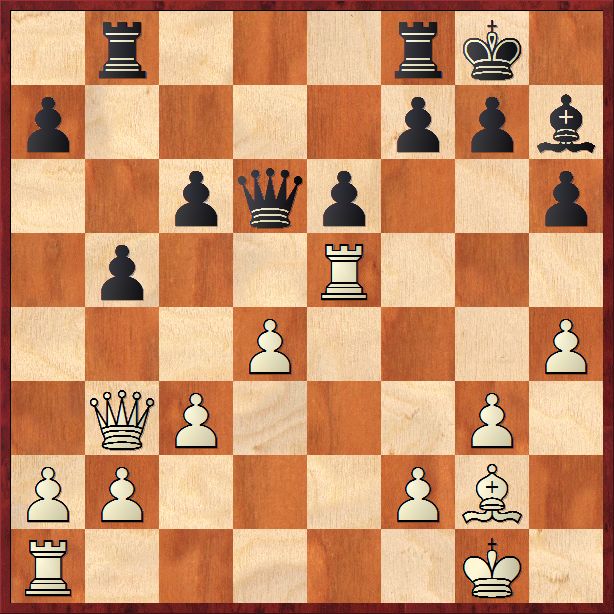
Up to this moment Fedoseev performed brilliantly, and Black is already up against considerable difficulties. Remaining true to his credo, Alexander tries to give his young partner a head-on fight and is willing to sacrifice a pawn for this purpose.
23...Bd3!? 24.Rc5 Bc4 25.Qa3?!
Vladimir prefers to pick up material with the queens on the board when his army’s commander is, in fact, completely devoid of defenders. Stronger was 25.Qb4! Bd5 26.Rxb5 Qxb4 27.Rxb4 Rxb4 28.cxb4.
Although it might at first glance appear that after 28...Rd8 29.Bxd5 Rxd5 30.Rd1 e5 Black wins the pawn back, the white king is, however, closer to the theatre of action - 31.Kf1 exd4 32.Ke2, and in the case of 32...a5 33.Rc1 axb4 34.Rxc6 Ra5 35.Rc4 Rxa2 36.Rxb4 White would have remained up a pawn with significant winning chances.
A bird in hand seemed not enough to Volodya, plus the nuances of the arising rook ending were to be evaluated in the advanced calculations. However, the bush with two birds turned out to be out of reach.
25...Bd5 26.Bxd5 exd5 27.Qa6
It is to be done throught this move order, since 27.Qxa7 Rfe8 would have left Black with the intact pawn structure and allowed him to take up an open file. However, Alexander goes about activating his "canons" without further delay.
27...Rbc8 28.Rxb5 f5! 29.Rb7 f4 30.Qd3 Rce8 31.Qf3
31.Rf1 Re4 32.Rxa7 Qe6. The queen is timely back to defend the king as White is not happy about 31.Rf1 Re4 32.Rxa7 Qe6.
31...fxg3
Black cannot allow the consolidating 31...Re4 32.g4!
32.Qxg3
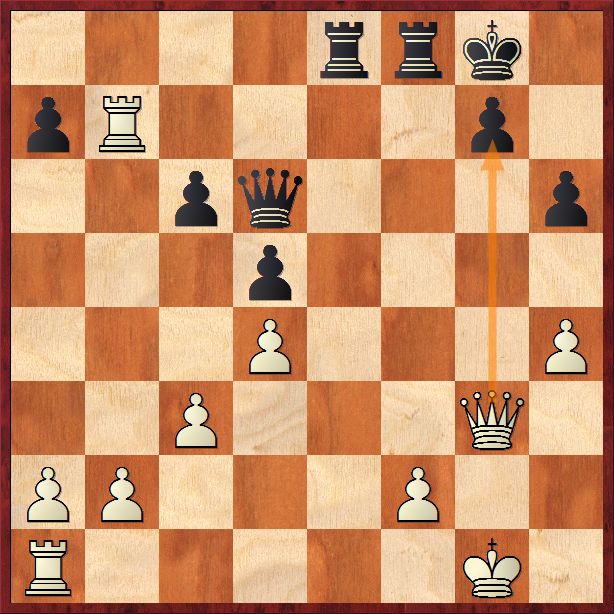
32...Qf6!
This principled decision appears to be unexpected by White, who was obviously anticipating 32... Qxg3+ 33.fxg3 Rf3 with a draw in the rook ending. Fedoseev went into thinking but reacted rather poorly.
33.Kf1?
As was pointed out by S. Shipov White should have gone about eliminating the enemy pawns without any prejudice: 33.Rxa7 Re2 (I wish to add for myself 33... Re4 34.f3 Re2 35.Rb7 or 34... Rxh4 35.Re1) 34.Rf1 Rxb2 35.Rd7 with a likely draw. Now White is in trouble.
33...Re4 34.Rb8 Rxb8 35.Qxb8+ Kh7 36.Qg3 Rxh4 37.Kg2 Re4
In order to extricate himself from the mating threats, the native of St. Petersburg had to give back the pawn and to exchange his active rook, and now his position has become extremely precarious.
38.Rg1
This is a smart way to create counterplay because 38.Rh1 Qe6 39.Rh4 Re2 does not seem good at all.
38...Qe6 39.f3 Re3 40.Kf2 g5 41.Kg2 Re2+ 42.Kh1 Rxb2 43.Re1 Qf5 44.Qg4?
This is a final step towards self-destruction as White has misjudged the arising rook ending. For better or for worse, it was essential to go for 44.Kg1, when Motylev would have to choose between the cautious 44... Rb7 and the bold 44... Kg6 (44... Rxa2? 45.Qd6 is losing).
44...Qxg4 45.Re7+ Kg8 46.fxg4 Rxa2 47.Re6
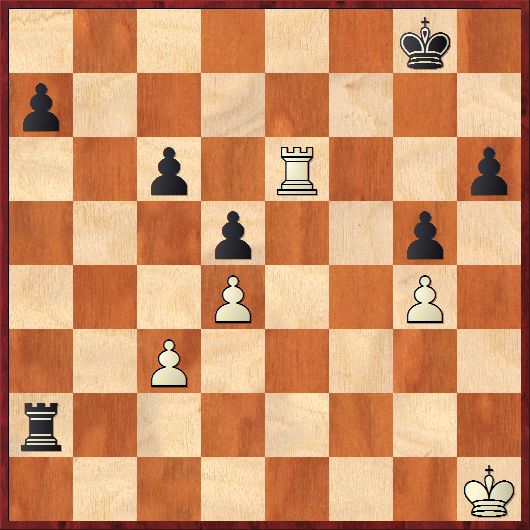
White is down two pawns, but how should Black take immediate care of all his own threatened pawns? If the c6-pawn drops, he is going to face problems with the d5-pawn, if the one on h6 drops her g5-fellow is in for trouble... However, once in the endgame one should always keep in mind that he can just go on pushing his pawns forward towards the queening square.
47...a5! 48.Rxh6
48.Rxc6 a4 49.Rxh6 a3 50.Ra6 Kf7 does not make any difference as the black king still heads for с4.
48...a4 49.Rd6 a3 50.Rd8+ Kf7 51.Rd7+ Ke8 52.Ra7 Kd8 53.Kg1 Kc8 54.Kf1 Ra1+ White resigns.
Despite some single mistakes, it has turned out to be a large-scale battle of two ambitious players!
The third obstacle in the way of Motylev was the adamant Vladimir Malakhov, who participated in the Higher League last time as far back as 2008, when he suffered a bitter defeat at the decisive moment of the tournament race because of his mobile phone suddenly becoming active. Malakhov was so upset that he has made an impressive pause in the Russian qualification system since then. In Kaliningrad Vladimir has outplayed Chigaev and Landa, but was unable to withstand the ramming forces applied by his opponent, whom Malakhov was competing with way back in the Russian Junior Championships.
Motylev – Malakhov
Ruy Lopez
1.e4 e5 2.Nf3 Nc6 3.Bb5 Nf6 4.d3 Bc5 5.c3 0–0 6.0–0 Re8
In this offshoot of "anti-Berlin" the main alternative is the "Kramnik line” with 6... d6 7.Nbd2 Ne7 or 7.h3 Ne7. Malakhov, however, gives preference to Levon Aronian’s plan.
7.Re1
In the recent Russian Team Championship Malakhov obtained a reasonable position against Svidler: 7.Bg5 h6 8.Bh4 Bf8 9.Nbd2 d6 10.Re1 Bd7 11.Nf1 Be7 12.Ne3 Ng4 13.Bg3 Nxe3 14.Rxe3 Bf6, when Peter Veniaminovich suddenly blundered a pawn by playing 15.d4? Nxd4!
7...Bf8
This risky retreat of the bishop was employed by Malakhov in his half-forgotten game against Hansen. The well-known line runs as follows: 7... a6 8.Ba4 b5 9.Bb3 d6 10.Bg5 Be6 11.Nbd2 h6 12.Bh4 Bxb3 13.axb3 Nb8 (Anand - Carlsen, 2013). Unlike the Viking, the grandmaster from the Moscow-area is prepared to allow White’s breakthrough in the center, which is like bargaining with the devil.
8.d4 exd4 9.e5 Nd5 10.cxd4
The encounter Hansen – Malakhov, 2013 saw 10.Qb3 Nb6 11.cxd4 d5 12.Bg5 Qd7 13.Rc1 a6 14.Bxc6 bxc6 15.Nbd2 a5 16.Qc2 Bb7 17.a4 Nc4 18.Nf1 Qe6 19.b3 Nb6 20. Ng3 Nd7, and Black is already in a very good shape. This is a typical Malakhov’s trademark style of play! Motylev’s style is a lot more purposeful, however.
10...d6 11.Bg5 Qd7 12.Nc3 Nxc3
12...dxe5 loses to 13.Nxe5 Qd6 14.Nxd5 Qxd5 15.Bc4, but 12...a6!? in order to discourage White’s bishop from returning to d3 is interesting.
13.bxc3 a6 14.Bd3
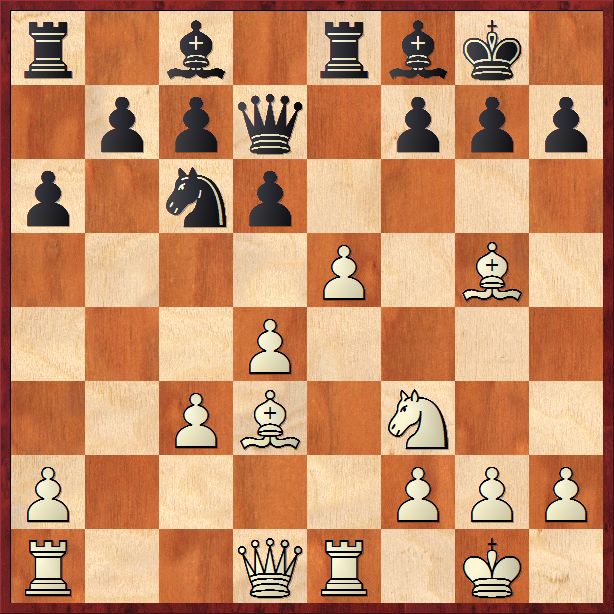
Any ordinary player would have gone down in this position in some 10 moves if playing Black. Quite sad is 14...g6 15.Bf6; 14...dxe5 15.d5; 14...h6 15.Bf4; 14...d5 15.Bc2 Nd8 16.Qd3 g6 17.Bf6 Ne6 18.Qe3 – a mating threat is looming over the black king in all lines. However, Malakhov comes up with a way of rearranging his forces.
14...b5 15.Qc2 h6 16.Bh4 Rb8
The rook sidesteps the x-ray in advance 16...dxe5 17.dxe5 Qd5 18.Be4.
17.Re3!
Alexander steps up the threats, and it is a correct approach, as the type of positions arising after 17.exd6 Rxe1+ 18.Rxe1 cxd6 cannot be won against the likes of Vladimir Malakhov.
17...dxe5 18.dxe5 Qd5! 19.Rd1 Qc5 20.h3 Be6 21.Nd2 Bd5

Black has achieved a lot: the queen is active and the bishop has been deployed on the big diagonal. On the other hand his pieces seem like being on the loose somewhat. I think that either Vladimir himself or any imaginary Peter Leko would have opted here for 22.Nb3!? Bxb3 23.axb3 Rxe5 (bad is 23... Nxe5 24.Qe2) 24.Be4 Rbe8 25.Bg3 R5e6 26.b4 Qb6 27.Bh7+ Kh8 28.Rxe6 Rxe6 29.Bf5 with two raging bishops and prolonged pressure for a missing pawn. Motylev rejects half measures and continues playing for a mate.
22.Rde1
Here Black had a sudden breakdown happened to him. 22...Qb6 looked good with the idea of bringing the bishop over to c5, but Malakhov miscalculated somewhere.
22...Be7?! 23.Bf6! Bf8?
Losing is 23...gxf6 24.exf6, whereas 23...Bxf6 24.exf6 Rxe3 25.Bh7+ Kh8 26.fxg7+ Kxg7 27.Rxe3 is quite dangerous. However, Shipov rightly pointed out to 23...Rad8!, preparing simplifications. Now White's attack becomes very dangerous.
24.Rg3?!
Even stronger is 24.Qd1 Ne7 (24...gxf6 25.Qg4+ Kh8 26.Qf5) 25.Qh5, since the transfer of the white rook afforded Black an incredible defensive computer-like resource.
24...Rb6?
In the case of 24...Kh8! White could have started the fascinating sequence of moves 25.Nb3 Qb6 26.Nc5!! (26.Qd2 gxf6), which could be met by a brilliant 26...Nxe5!! (leading to a mate is 26...Qxc5 27.Qd2 gxf6 28.Qf4 Bg7 29.Rxg7 Kxg7 30.exf6+) 27.Rxe5 Qxf6 28.Rxd5 Qc6!! (S. Shipov), and Black miraculously wins the piece back.
25.Qd1 Ne7 26.Qh5 g6
26...Ng6 27.Ree3 does not bring any relief either.
27.e6!, and Black resigned as after 27...Rxe6 28.Rxe6 the bold rook cannot be recaptured.
Motylev came out clear first, while the former lead Ivan Popov missed his chance at a nice win and succumbed to Ildar Khairullin.
Popov – Khairullin

18.f4?
There comes to mind unfortunate Paul Petrovich Keres, who fell behind Smyslov in one of the candidate’s tournaments largely because of the defeat from Averbakh as Keres blundered a thrust of one of the opponent's king pawns. All the commentators pointed out that the victory was to be attained by
18.Nh6+! Kf8
(Black starts crumbling along the central diagonal also in the case of 18...Kg7 19.Nef5+ Kf8 20.Nxd6 cxd6 21.f4 Nxf4 22.Rxf4 exf4 23.Qxf4)
19.f4 Nxf4, when White has a choice among the extremely attractive 20.Nef5! Qf6 21.Rxf4! gxf5 22.Qg8+ Ke7 23.Qxh7 Rh8
(or 23...Qg6 24.Nxf5+ Bxf5 25.Qh4+)
24.Nxf5+ Kd7 25.Nxd6, and the earthbound 20.Qf3! Qg5 21.Neg4.
18...h5! 19.Qd1 gxf5 20.fxe5?!
20.Nxf5 Bf8 21.Qxh5 Ng7 22.Qg4 would have retained pressure in the position, while an attempt at grabbing as many Black’s pawns as possible allowed Khairullin to consolidate his position.
20...Bf8 21.Rxf5
White should have put up with 21.axb5 axb5 22.Qxh5 Qg5 23.Qxg5+ Nxg5 in order to try to bail out with a draw. However, after
21...Nd4 22.Rxh5 Bg7 23.axb5 axb5 24.c3
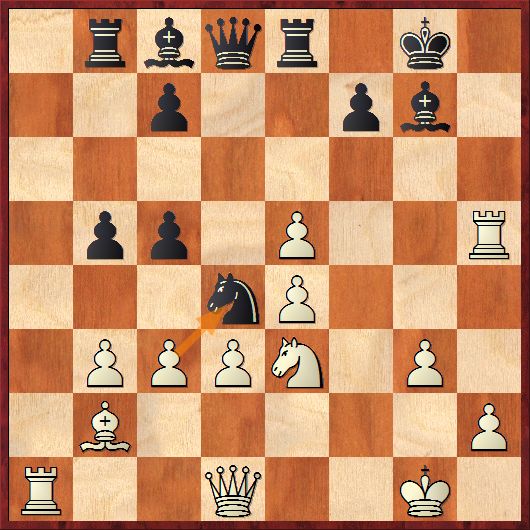
there followed a memorable shocker 24...Nxb3!!
And then again, we cannot but mention the cold-blooded 24...Nc6! 25.d4 b4! (S. Shipov). However, we are celebrating a feast of nice chess.
25.Qxb3 Qxd3 26.Nf5 Qxe4 27.Rf1 c4 28.Qd1 Bb7, and White suffered significant loss of material.
However, Vanya immediately summoned all his strength and won with black pieces against Anton Demchenko in one of the offshoots of the Rauzer variation, which, according to Chess Base, is defended by someone named D. Kryakvin with persistence worthy of a better application.
The group of Motylev’s pursuers has been joined by Daniil Dubov, who defeated Pasha Ponkratov in a principled gambit duel.
Ponkratov – Dubov
Benko Gambit
1.d4 Nf6 2.c4 c5 3.d5 b5 4.cxb5 a6 5.Nc3 axb5 6.e4!? b4 7.Nb5
A cute and clever, but rather outdated idea by Igor Abramovich Zaitsev. The point is that in the case of 7...Nxe4 8.Qe2 f5 9.f3 Black should give up his knight unless he wishes to get smothered mated on d6. One of the most creative Russian players has recently sought to revive White’s idea.
7...d6 8.a4!?
This is Ponkratov’s recipe. 8.Bf4 or 8.Bc4 have been employed on a large-scale basis. The youngest grandmaster of the UFD is prepared to give for free the central pawn to one of the youngest Moscow grandmasters.
8...Nxe4 9.Bc4 Nf6 10.Qe2 Ra6 11.Bg5 h6 12.Bxf6 gxf6 13.Nf3
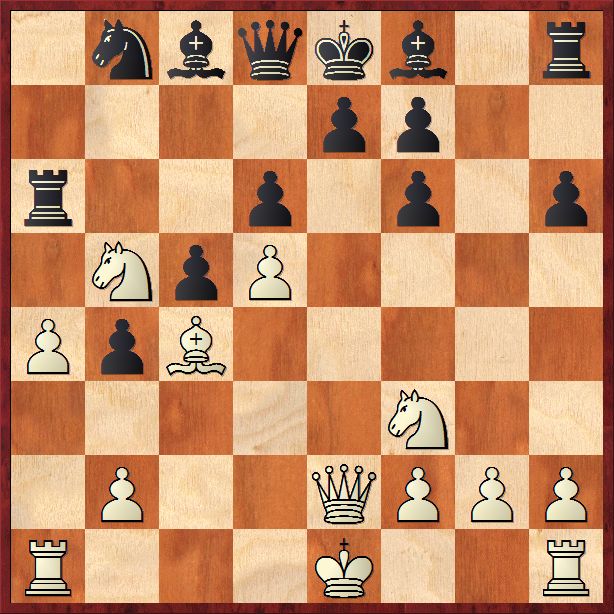
All of this was seen in the Moscow-Open, when after 13...f5 14.0-0 Bg7 15.Ra2 Kf8 16.b3 Ra8 17.Nh4 Bf6 18.Qh5 Bxh4? (correct is 18...f4!) 19.Qxh4 Ba6 20.Re1 Nd7 21.Nxd6 exd6 22.Qxd8+ Rxd8 23.Bxa6 Pasha got a sizeable advantage against Nikolay Konovalov, but the game ended in a draw. Dubov is prepared for a repetition, but Ponkratov introduces some precision into the previous order of moves.
13...Bg7 14.b3 f5 15.Rd1 Bf6 16.0–0 Kf8 17.Rfe1 Ra8 18.Bd3 Na6 19.Qc2?!
The mobilization is over, and it is a little weird that Ponkratov refrained from winning back the f5-pawn immediately after 19.Nd2 Rg8 (19...Nc7 20.Nxc7 Qxc7 21.Qh5) 20.Qh5, retaining pressure at material equality. Longer operation aimed at recapturing the sacrificed material allowed Daniil to rearrange his forces.
19...Qd7 20.Nd2 Rg8 21.f4 Nc7 22.Nxc7 Qxc7 23.Bxf5 Bb7!
Or course not 23...Bxf5 24.Qxf5 so as to keep the bishop pair advantage!
24.Be4 Bc3 25.Kh1
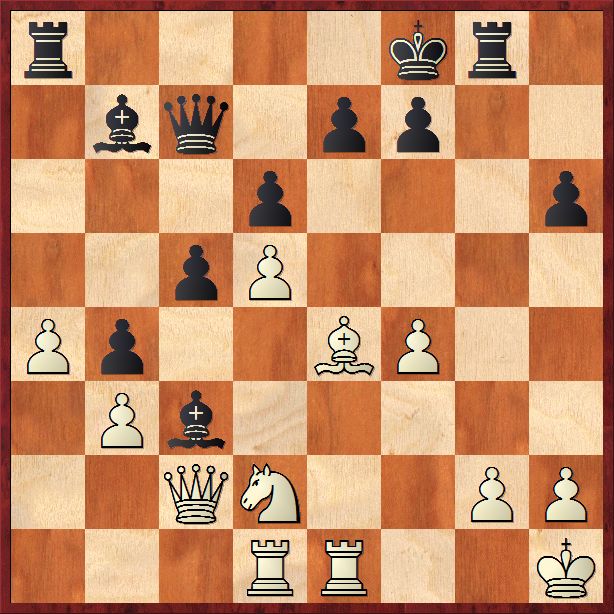
25...c4! 26.bxc4?
How come? The counter exchange sacrifice would have resulted in a sharp complex game: 26.Nxc4! Bxe1 27.Rxe1 Ba6 28.Qd2! Bxc4 29.Rc1 Qb7 30.Rxc4 Rc8 31.Rc6, whereas now Black has a clear edge.
26...Bc8 27.Bf3 Bd7 28.Qh7 Rh8 29.Qd3 Rxa4 30.Re2 Qa7 31.Rde1 Bf6
You might have followed the video review in which our expert commented richly on the realization of advantage by his trainee. I would like to add for myself, that Pasha's idea is still very good, and I hope that my friend will someday score a nice win in this line.
After six rounds Alexander Motylev is ahead with 4.5 points, and he is chased by Ivan Popov, Daniil Dubov, Ildar Khairullin, Dmitry Frolyanov, Vladislav Artemiev and Vadim Zvjaginsev. There are only five tickets into the Superfinal, so we are in for a very hot finish of the event!













